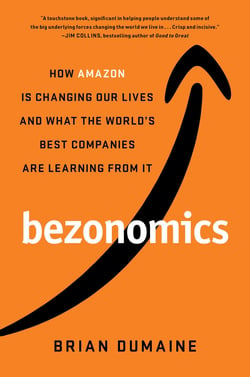 Your stock has dropped from $107 down to $6 a share. Wall Street predicts your company will run out of cash by yearend.
Your stock has dropped from $107 down to $6 a share. Wall Street predicts your company will run out of cash by yearend.
What do you do?
This isn’t 2020, the COVID-19 crisis. This is 2001, and it’s Jeff Bezos struggling through the dot.com bust. Amazon.com is in a tailspin. From 2000 to 2005, Brian Dumaine, notes in Bezonomics: How Amazon Is Changing Our Lives and What the World's Best Companies Are Learning from It, tech stocks on the NASDAQ exchange lost $5 trillion in market value.
Immediately following the 9/11 attacks, this shock was compounded at Amazon. The company lost its way. Cost cutting, fired employees, fed the chaos and fear inside the company.
At the same time Jim Collins published, Good to Great.
Bezos invites Collins to Seattle to coach his executive team about how to get out of a crisis.
Collins told them to build a new engine for growth called the flywheel.
“What I told them, is you want to respond in times like this not by reacting to bad news but by building a flywheel,” Collins shared.
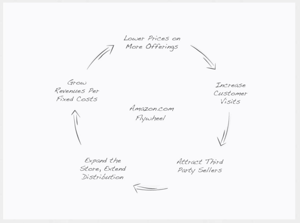 Dumaine shares, “At the meeting with the board, Collins says Bezos was “really sharp and a good listener.” In retrospect, Collins believes the Amazon CEO had always been an instinctive “flywheel-level thinker” but simply lacked the language for it. When Collins sketched out the concept, it was for Bezos a crystallization of an orientation and discipline he’d already displayed since his founding of the company. “Jeff was like a great student,” says Collins, “who just gets stuff and then takes it to a far higher level than you ever imagined.”
Dumaine shares, “At the meeting with the board, Collins says Bezos was “really sharp and a good listener.” In retrospect, Collins believes the Amazon CEO had always been an instinctive “flywheel-level thinker” but simply lacked the language for it. When Collins sketched out the concept, it was for Bezos a crystallization of an orientation and discipline he’d already displayed since his founding of the company. “Jeff was like a great student,” says Collins, “who just gets stuff and then takes it to a far higher level than you ever imagined.”
Every great company, organization, or sports team success is never due to a single event or a single idea. Greatness isn’t about the person who gets there first, nor is it due to a big acquisition. Success comes from pushing a big flywheel.
What the Flywheel is NOT
Collins shared what the flywheel is NOT:
- A line of business; it is an underlying architecture of momentum renewed and extended into multiple businesses and activities. New technologies are powerful flywheel accelerators helping to take the wheel from millions of turns to billions of turns.
- A list of priorities drawn in the shape of a circle. It’s a way of thinking. There is no one big push to make it go. You wouldn’t ask, what was the one investment that made Warren Buffett great? It isn’t a single act or decision. It’s a series of good decisions made with a coherent concept. In Amazon’s case it’s being “genuinely customer centric”—that over time accumulate one after the other and give a company momentum.
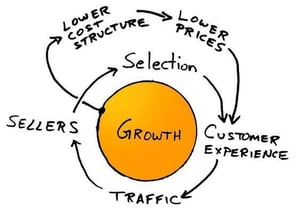 Bezos jumped on the idea. He and his team sketched what Amazon’s flywheel should look like. Amazon is focused on driving down costs for its customers and improving service. The first spot on his flywheel sketch was lowering costs for customers. By lowering costs Amazon increases the number of customers who visit Amazon.com. This attracts more third-party sellers who want to reach the growing traffic on Amazon’s platform—the second spot on the flywheel—which leads to more revenue for Amazon. That leads to economies of scale that help lower prices for customers—the third spot on the flywheel. This pulls in more customers, and Bezos was right back where he started on his sketch of the flywheel. The circle was complete.
Bezos jumped on the idea. He and his team sketched what Amazon’s flywheel should look like. Amazon is focused on driving down costs for its customers and improving service. The first spot on his flywheel sketch was lowering costs for customers. By lowering costs Amazon increases the number of customers who visit Amazon.com. This attracts more third-party sellers who want to reach the growing traffic on Amazon’s platform—the second spot on the flywheel—which leads to more revenue for Amazon. That leads to economies of scale that help lower prices for customers—the third spot on the flywheel. This pulls in more customers, and Bezos was right back where he started on his sketch of the flywheel. The circle was complete.
Virtuous Cycle
Bezos recognized if he could get his employees to focus their attention on any of these components—traffic, sellers, selection, or customer experience—that would distribute more energy to all the spots on the flywheel. The whole system grows. Bezos understood these linkages beautifully.
Watch as Amazon explains their Virtuous Cycle to their employees in 3 minutes 30 seconds.
Flywheels are not static. This is Bezos’s second tenet of Bezonomics. To keep Amazon’s momentum going even faster, Bezos understands Amazon needs to continually renew each element of the flywheel by innovating.
All of Amazon’s major innovations, from the Kindle to AWS to the Echo, took many years. When Amazon failed, it kept innovating. Bezos felt no matter the outcome, these efforts would pay off in the long run. Example, learning from the failed Fire Phone, ended up in Amazon’s successful smart speaker, the Echo.
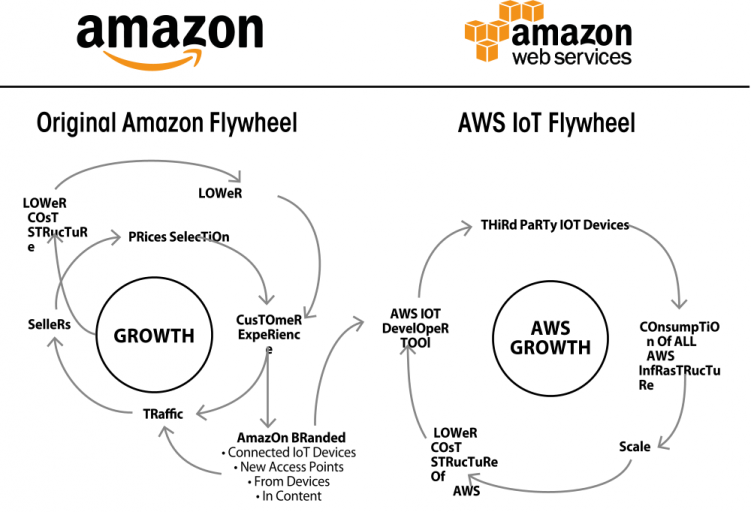 CLIMB OUT OF COVID-19
CLIMB OUT OF COVID-19
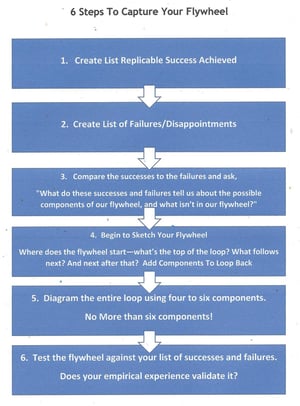 Do you need to transform your business? Jeff Bezos calls Amazon’s Flywheel their “secret sauce.” It’s responsible for transforming Amazon to the colossus it is today.
Do you need to transform your business? Jeff Bezos calls Amazon’s Flywheel their “secret sauce.” It’s responsible for transforming Amazon to the colossus it is today.
The flywheel principle is an integral part of Positioning Systems Strategic Discipline coaching. We’ve helped $1M to $2 Billion size businesses discover their Flywheel. If you’re struggling to gain momentum in the Post COVID-19 new normal, discovering your Flywheel can rejuvenate your business! Get your team focused on the elements to make you great!
Schedule a meeting HERE to discuss exploring your Flywheel.
Growth demands Strategic Discipline.
To build an enduring great organization, requires disciplined people, disciplined thought, disciplined action, to produce superior results, and make a distinctive impact in the world.
Discipline sustains momentum, over a long period of time, laying the foundations for lasting endurance.
-2.jpg?width=300&name=3%20Disciplines%20of%20Execution%20(Strategic%20Discipline)-2.jpg) A winning habit starts with 3 Strategic Disciplines: Priority, Metrics and Meeting Rhythms. Forecasting, accountability, individual, and team performance improve dramatically.
A winning habit starts with 3 Strategic Disciplines: Priority, Metrics and Meeting Rhythms. Forecasting, accountability, individual, and team performance improve dramatically.
Meeting Rhythms achieve a disciplined focus on performance metrics to drive growth.
Let Positioning Systems help your business achieve these outcomes on the Four most Important Decisions your business faces:
|
DECISION |
RESULT/OUTCOME |
|
PEOPLE |
|
|
STRATEGY |
|
|
EXECUTION |
|
|
CASH |
|
Positioning Systems helps mid-sized ($5M - $250M) business Scale-UP. We align your business to focus on Your One Thing! Contact dwick@positioningsystems.com to Scale Up your business! Take our Four Decisions Needs Assessment to discover how your business measures against other Scaled Up companies. We’ll contact you.
NEXT BLOG – Amazon Proof?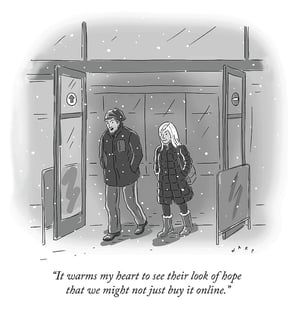
COVID-19 is accelerating the demise of retail. Retail locations in the US outnumber those of the global economy 4 to 1. The decline of retail outlets may have been inevitable. While retail recedes, Amazon is opening more retail locations. Is there a way to Amazon proof your business? That’s next blog.






.jpeg?width=150&height=135&name=Hand%20with%20marker%20writing%20the%20question%20Whats%20Next_%20(1).jpeg)

